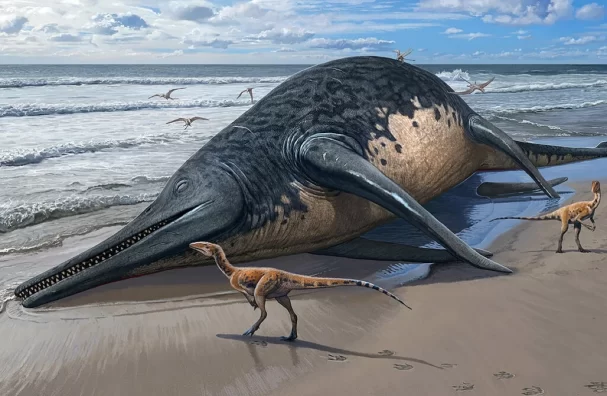
In the ancient oceans of our planet, gigantic creatures once ruled the waves. Among them was a marine reptile so massive that it could rival the size of the colossal blue whale. Through meticulous research and excavation, a team of dedicated paleontologists in Somerset, UK, has unearthed the remains of the largest ichthyosaur ever found. This discovery has immense implications for our understanding of marine life during the Mesozoic era.
The ichthyosaur, a marine reptile from the Mesozoic era, has been long known to paleontologists. However, the recent discovery in Somerset has completely upended previous size estimates. The findings suggest that these sea monsters could have reached a staggering length of over 30 meters, potentially surpassing even the largest blue whales.
The discovery was led by Dean Lomax, a renowned paleontologist at the University of Manchester. His team unearthed a surangular – a bone located at the top of the lower jaw, behind the teeth. This bone measured a remarkable 2.3 meters, which is 25 percent larger than the surangular found in the previously largest known ichthyosaur skeleton.
Ichthyosaurs were a diverse group of marine reptiles that roamed the oceans for nearly 160 million years. Despite their long reign, much about their biology, behavior, and evolution remains a mystery. They possessed a dolphin-like body shape, complete with a long, slender snout filled with sharp teeth and a powerful, vertically oriented tail. Their four limbs had evolved into flippers, enabling them to navigate the ancient seas with remarkable agility.
The largest ichthyosaur species previously known, the Shonisaurus sikanniensis, measured 21 meters in length. However, the new discovery suggests that some ichthyosaurs could have been even larger. By extrapolating the size of the surangular to the rest of the body, Lomax’s team estimated that this newly discovered ichthyosaur could have measured between 22 and 26 meters.
An intriguing aspect of the discovery was the absence of an external fundamental system (EFS) in the surangular. The EFS is a layer of tissue that signifies the end of bone growth, indicating that the animal had reached its full size. The absence of EFS suggests that the giant ichthyosaur was still growing at the time of its death, implying that it could have grown even larger.
